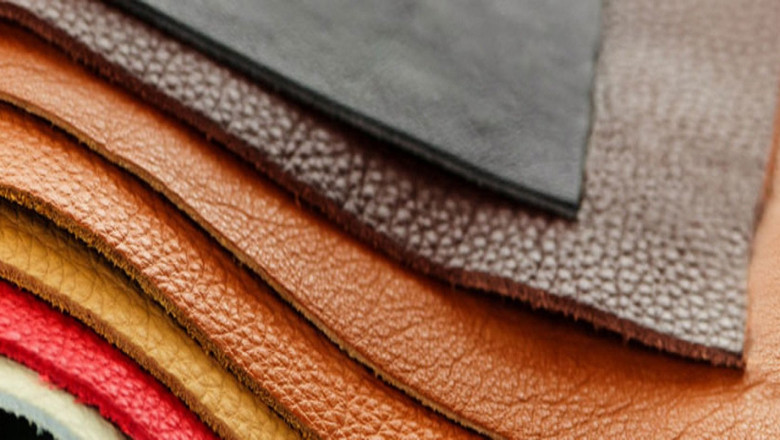views
Bio-Based Leather Market Overview: Key Innovations and Growth Factors Driving Industry Development
The global bio-based leather market is rapidly evolving as industries and consumers alike increasingly seek more sustainable and ethical alternatives to traditional leather. Bio-based leather, derived from renewable materials such as plants, fungi, and agricultural by-products, offers a cruelty-free and eco-friendly option to conventional animal hides. As demand for environmentally friendly products rises, key innovations and growth factors are fueling the development of the bio-based leather market. This article explores the latest trends, innovations, and key growth drivers shaping the bio-based leather industry.
Market Overview
Bio-based leather is an alternative material made from renewable biological sources such as pineapple leaves, mycelium, cactus, and various agricultural by-products. These materials closely mimic the characteristics of traditional leather, such as durability, texture, and appearance, but without the negative environmental impacts associated with animal leather or synthetic options. Industries such as fashion, automotive, furniture, and upholstery are increasingly adopting bio-based leather due to its sustainability and eco-friendly properties.
As consumer preferences shift toward more sustainable products, the bio-based leather market is poised for continued expansion. The market's growth is underpinned by innovations in material science, technological advancements, and the increasing focus on sustainability and ethical production.
Key Innovations in Bio-Based Leather
-
Mycelium-Based Leathers: One of the most significant innovations in the bio-based leather market is the development of mycelium-based leather. Mycelium, the root structure of fungi, is being used to create durable, biodegradable leather alternatives. Companies like MycoWorks and Bolt Threads are at the forefront of this innovation. Mycelium-based leathers are not only environmentally friendly but also customizable in terms of texture, thickness, and color, making them an ideal choice for the fashion and automotive industries.
-
Pineapple Leaf-Based Piñatex: Piñatex, developed by Ananas Anam, is another groundbreaking bio-based leather alternative made from pineapple leaf fibers. This material is durable, lightweight, and versatile, making it suitable for a wide range of applications, from footwear and accessories to furniture and automotive interiors. Piñatex is gaining significant traction in the fashion industry as a sustainable alternative to traditional leather.
-
Cactus-Based Leather: Desserto, a cactus-based leather, is gaining popularity for its low environmental impact and biodegradability. Made from the nopal cactus, this bio-based leather is durable and provides an eco-friendly alternative to traditional leather. Cactus leather is used in various industries, including fashion, furniture, and automotive, and is valued for its softness and flexibility.
-
Seafood Shell and Mushroom-Based Leathers: Startups like TômTex are innovating with bio-based leather alternatives made from seafood shell waste (chitosan) and mushrooms. These materials not only reduce waste but also contribute to a circular economy by using agricultural and industrial by-products to create high-quality leather alternatives. These innovations offer eco-conscious consumers more sustainable options while minimizing environmental waste.
Growth Factors Driving Industry Development
-
Sustainability and Ethical Consumer Demand: One of the primary growth drivers for the bio-based leather market is the increasing consumer demand for sustainable and ethically produced products. Consumers are becoming more environmentally conscious and are actively seeking out cruelty-free and eco-friendly alternatives to traditional leather. Bio-based leather provides a viable solution to meet these growing expectations while reducing the environmental impact associated with conventional leather production.
-
Technological Advancements in Material Science: Ongoing innovations in biotechnology and material science are key drivers of bio-based leather market growth. Researchers and manufacturers are developing new materials with enhanced durability, texture, and performance, making bio-based leather increasingly suitable for high-end applications in fashion, automotive, and furniture industries. Advances in production techniques have also made bio-based leathers more affordable and scalable.
-
Government Regulations and Incentives: Governments worldwide are introducing policies that support sustainability and eco-friendly practices, which are encouraging companies to adopt bio-based leather solutions. Regulatory frameworks in Europe and North America, in particular, are creating a favorable environment for the adoption of sustainable materials. Financial incentives and subsidies for companies producing eco-friendly products further boost market growth.
-
Corporate Social Responsibility and Industry Collaboration: Large corporations, especially in the fashion and automotive sectors, are adopting bio-based leathers as part of their sustainability strategies. Companies like BMW, Mercedes-Benz, and H&M have started using bio-based leathers in their products, which not only aligns with consumer preferences but also helps them meet their environmental and ethical goals. Collaboration between bio-based leather manufacturers and major global brands is fostering innovation, improving material performance, and increasing market visibility.
-
Rising Awareness of Environmental Issues: As the negative environmental impact of traditional leather production becomes more widely acknowledged, industries are increasingly turning to sustainable alternatives. Conventional leather tanning processes often involve harmful chemicals, extensive water usage, and high carbon emissions. Bio-based leathers, on the other hand, offer a more sustainable production process with a smaller carbon footprint and reduced environmental harm.
Challenges in the Bio-Based Leather Market
Despite the promising growth, the bio-based leather market faces challenges, including the high cost of production, limited raw material availability, and the need for ongoing improvements in durability and performance. Bio-based leathers may not yet meet the same performance standards as traditional leather in certain high-demand applications. However, with continued investment in research and development, these challenges are expected to be addressed in the coming years.
Conclusion
The bio-based leather market is experiencing significant growth, driven by key innovations, increasing consumer demand for sustainable products, and the adoption of ethical production practices. Mycelium-based leathers, pineapple leaf-based Piñatex, cactus leather, and other bio-based alternatives are revolutionizing industries like fashion, automotive, and furniture. As technological advancements continue to enhance the performance and affordability of these materials, bio-based leather is poised to become a mainstream material in various industries. With sustainability at the core of its growth, the bio-based leather market offers a promising future for both manufacturers and environmentally conscious consumers alike.






















Comments
0 comment